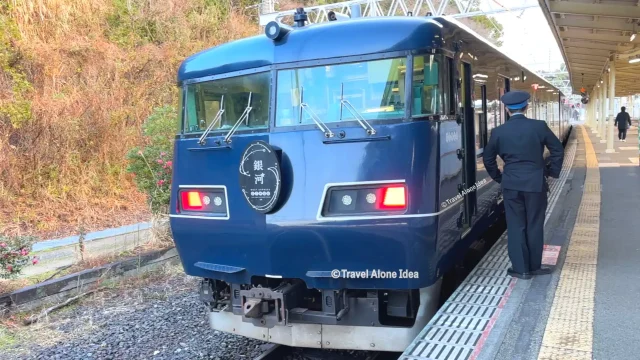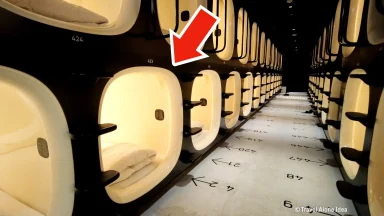Japan’s Newest Sleeper Train | The West Express Ginga
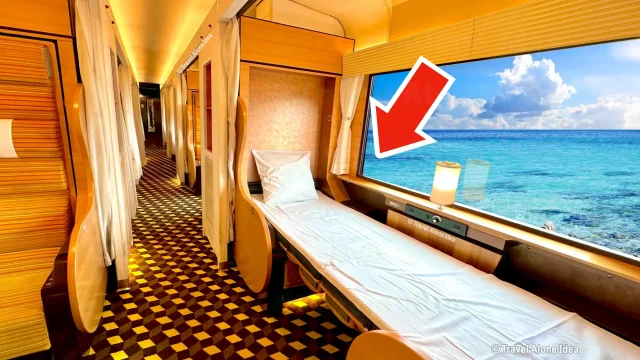
- Published Date
- Updated Date
The West Express Ginga is a popular sleeper train in Japan that is difficult to get reservations for. But actually, if you follow the method introduced in this article, it’s possible for anyone to ride it.
This is because it is important to prepare in advance. I had the opportunity to ride the West Express Ginga, so I’d like to share my experience with photos and videos.
On this page, a writer who makes a living by traveling will advise on those worries. YouTube channel
1. What is the West Express Ginga?
The West Express Ginga is a sightseeing train operated by JR West Japan. It operates about 2 round trips per week, changing its route seasonally. The concept of the train is “a train where you can enjoy a casual train trip.” The exterior of the train is painted in a deep blue color called “Rurikon-iro,” which represents the beautiful sea and sky that are the pride of western Japan.
The car body is a 117 Series train manufactured in the Japan National Railways era, which was renovated as a sightseeing train. The name “West Express Ginga” is derived from the meaning of the train connecting the stars, comparing the western Japan area to the universe and the scattered attractive regions to the stars.
During spring and summer, the San-in Course runs between Kyoto Station and Izumo City Station, and during fall and winter, the Kinan Course runs between Kyoto Station and Shingu Station. One of the attractions of this course is that passengers can enjoy short sightseeing and hospitality at stations along the way. Various seating and lounge spaces are available on board, including family cabins, premier rooms, and women-only cars.
Free Original Video (English Subtitles)
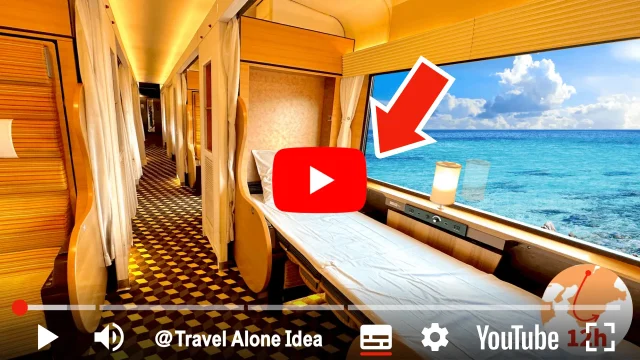
This time, I traveled alone from Kyoto Station to Shingu Station in Wakayama Prefecture (Kinan Course) in a semi-private room called the “First Seat” in the Green Car.
- The Premier Room for one person is especially recommended, as it is only located on the ocean side of the train.
- For family use, the “Family Cabins” also have a good view because they are only placed on the sea side.
2. Seat Types on the West Express Ginga
Green Private Rooms (Premier Rooms)
The West Express Ginga is a short 6-car train, and the Premier Rooms are located in Car No.6. They are fully private rooms with a lock, so you can rest assured!
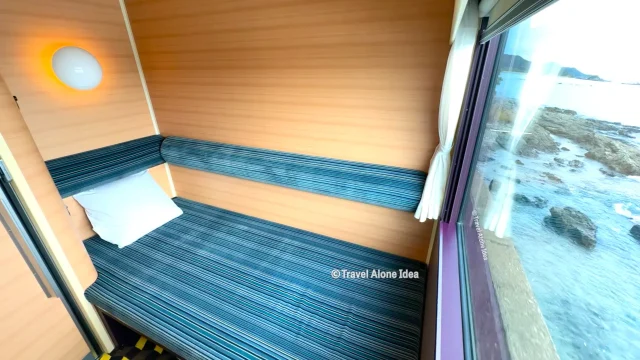
There are a total of five Premier Rooms, one for one person and four for two people. The private rooms for two people cannot be used by one person.
Nobi-Nobi Seats (Couchettes)
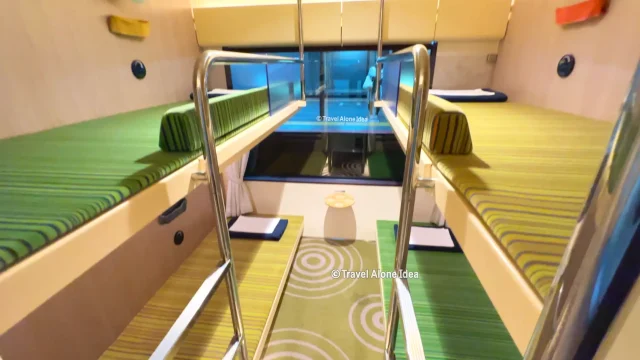
Car No.5 is for the cheapest sleeper seats, called the Nobi-Nobi Seats (affectionately known as the Couchettes). Each seat has individual lighting and a small wall shelf.
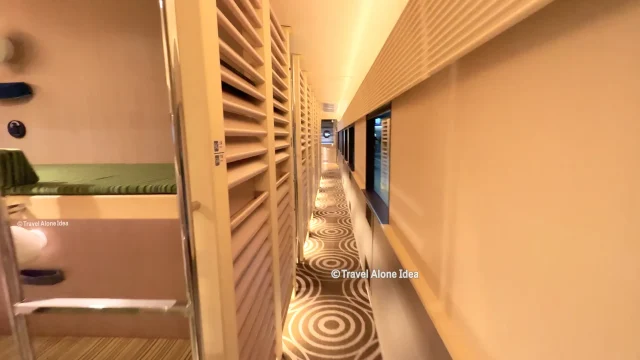
These are shared rooms, like the simple bunks of the past, but they are cleaned to the last detail and are very clean.
This is exactly the kind of typical sleeper train design that excites me!
Wheelchair-accessible Seats
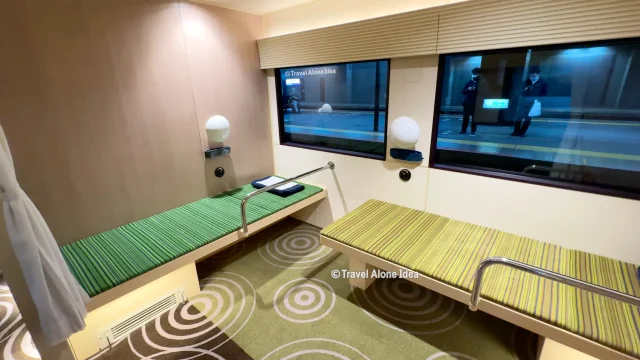
Wheelchair-accessible seating is also available. The couchette area has a total capacity of 18 passengers: four rooms for four people each and one wheelchair-accessible room for two people.
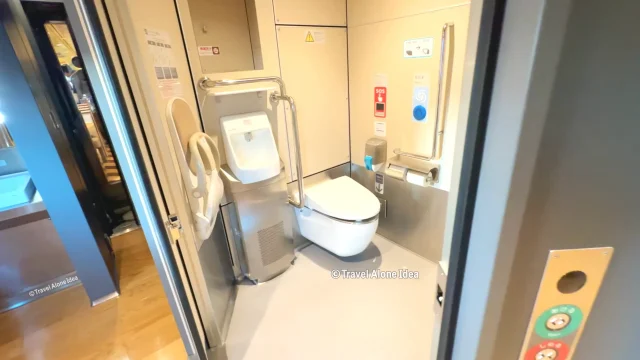
There is a handicap-friendly restroom and a washbasin directly next to the wheelchair-accessible seating. A baby chair, a baby bed, and a cloth-changing table are also conveniently provided!
Free Spaces and Lounges
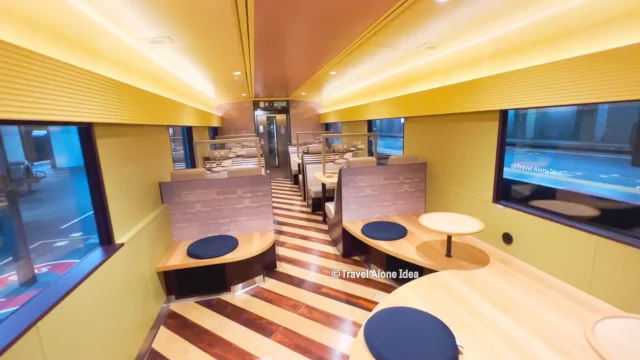
Car No.4 is entirely a free space named “Yu-Sei”. There are several other lounge spaces on the train.
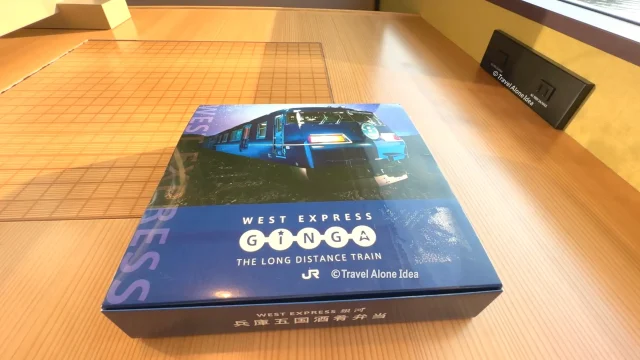
Eating and drinking are allowed in the free space, and the four box seat tables are stylishly decorated with engraved shogi(Japanese chess) boards and chess boards!
If you bring your own chess or other pieces, you can have fun playing against each other while traveling by train!
Compartments (Family Cabins)
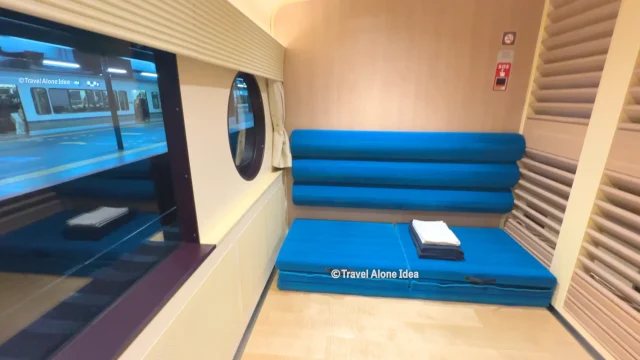
Car No.3 has two family cabins for family use, spacious rooms for 3-4 people.
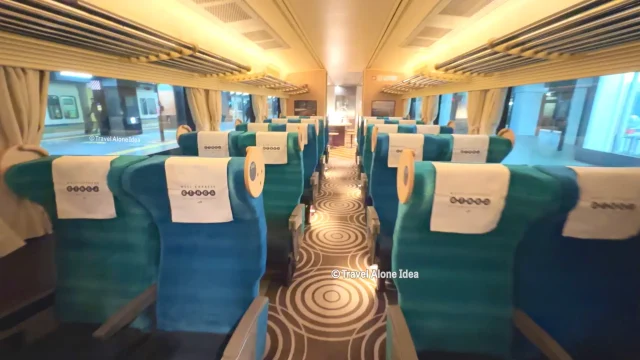
Next to them are the cheapest reclining seats. The reclining seats are cheaper, but unfortunately they cannot be fully flat.
Women-only Car
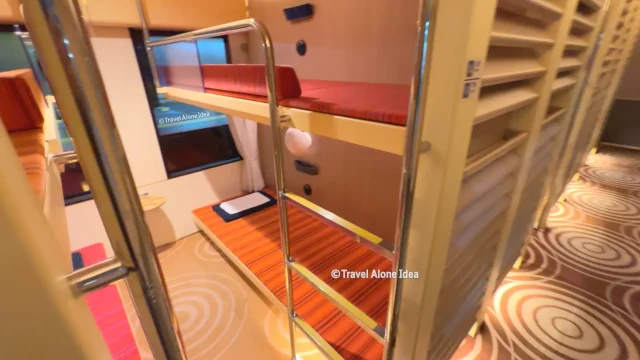
Car No.2 is a women-only car. There are two types of seats to choose from: couchette and reclining seats.
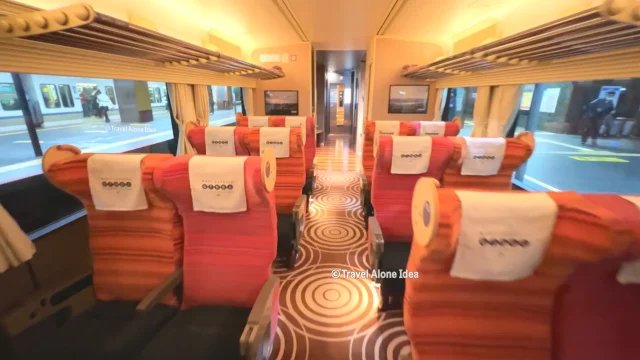
Thanks to the women-only car, women traveling alone can feel safe. What a surprise, a powder room is also available.
Male passengers can also enter and pass through if they are using Car No.1.
Green Car Reserved Seats (First Seats)
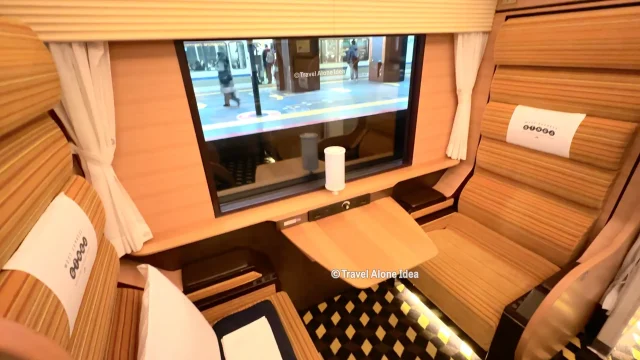
And car No.1 is for the sleeper seat called the First Seats that I used this time. The First Seats do not have a lockable door but if you close the curtain on the aisle side, it becomes a semi-private room.
3. Fares and Prices of the West Express Ginga
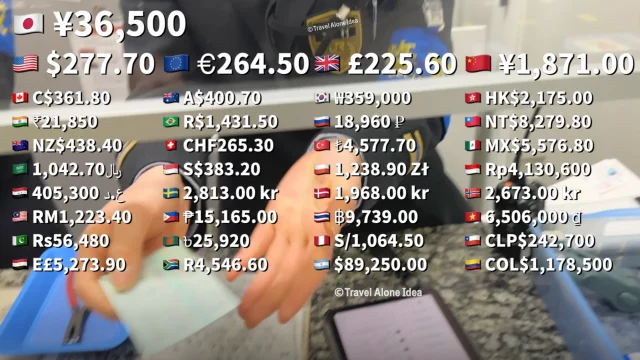
The fare of the West Express Ginga was 36,500 yen for round-trip transportation (using the First Seat from Kyoto Station to Shingu Station) and one night’s hotel accommodations.
The prices of tickets for the West Express Ginga vary depending on the distance, seat type, and hotel class. Please check the brochure on the official website to see if there is something that meets your needs.
4. How to book the West Express Ginga
The West Express Ginga’s tickets can be purchased through the JR West’s online reservation service called e5489 or at the ticket office called “Midori-no Madoguchi” at JR stations from 10:00 a.m. on the same day one month prior to the boarding date.
To make a reservation for the West Express Ginga, simply access the reservation page on the official website, select the seat type, then select the section of your ride, boarding date, and boarding and alighting stations. If seats are available, they will be displayed in the search results.
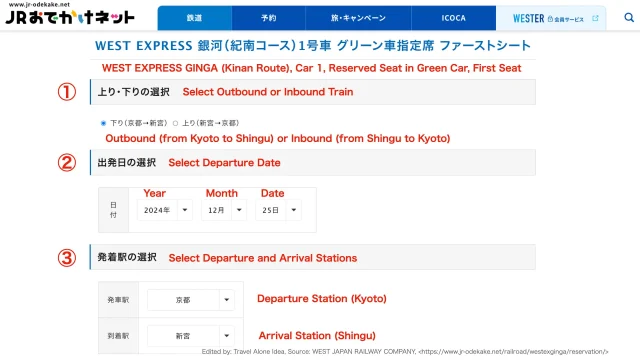
Reservations can also be made by phone using the reservation telephone number listed on the official website of Nippon Travel Agency. Reservations are accepted starting at 10:00 a.m. on each reservation start date.
Personally, I recommend making reservations by phone because it is faster, but it’s supposed that you will not be able to get the seat you want even if you call out of the blue. Please check the reservation start date and time in advance.
- When making reservations by phone, I recommend that you try to make reservations from multiple phones at the same time on the reservation start time.
- It is difficult to get through if you call at exactly 10:00 a.m. The trick is to call a few seconds before the reservation start time.
5. Routes of the West Express Ginga
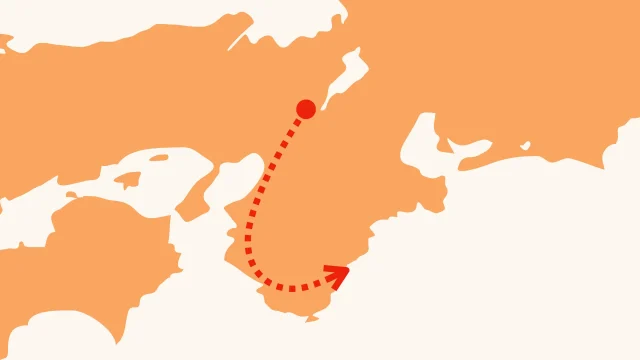
The Kinan Course of the West Express Ginga takes about 12 hours one way (departing Kyoto Station at 9:15 p.m. and arriving at Shingu Station at 9:37 a.m. the next morning) and travels slowly over a distance of 315 km (195mi).
Stations the West Express Ginga stops
- Departure from Kyoto Station
The West Express Ginga arrives at track 31 at 8:54 p.m., so be sure to arrive early if you want to take pictures of it! - Brief Stop at Shin-Osaka Station
In-train announcements will explain about the train and quizzes will be played. - Brief Stop at Osaka Station
The night view from the window is magnificent. - Long Stop at Wakayama Station
All passengers go to eat Wakayama Ramen, a specialty of the train. - Long Stop at Kushimoto Station
You can participate in a short sightseeing tour to see the famous strange rock formation called Hashigui-iwa and the beautiful sunrise. - Brief Stop at Kii-Katsuura Station
You’ll experience warm hospitality from the station staff. - Arrival at Shingu Station, the Last Stop
Upon arrival, you can join a walking tour to the World Heritage Site Kumano Hayatama-taisha Shrine
6. Access and Directions to Shingu Station
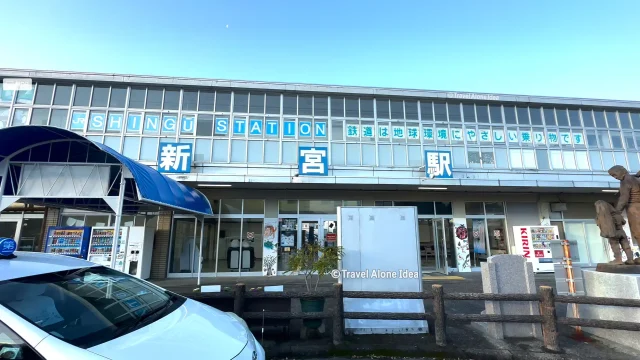
To get to Shingu Station, take a limousine bus from Nanki-Shirahama Airport for about 2.5 hours.
However, Nanki-Shirahama Airport is served only by JAL (Japan Airlines), so if you are going by ANA (All Nippon Airways), it will take 6 hours from Nagoya’s Central Japan International Airport (Centrair) by bus and train.
Shingu Station Basic information
| Name | Shingu Station (JR West Japan and JR Tokai) |
|---|---|
| Address | 2-1 Jofuku, Shingu-shi, Wakayama 647-0020, JAPAN |
| Access | About 2.5 hours by bus from Nanki-Shirahama Airport |
7. Reviews and Photos of the West Express Ginga
The West Express Ginga is a 6-car train with various type of seats, private rooms, and lounges. The train departs from Kyoto Station at 9:15 pm.
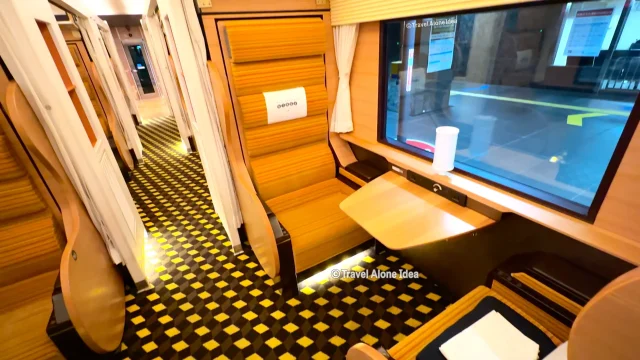
This is the semi-private room called the First Seat. If the train is operated overnight, the seats are used as beds as well, so two seats are available for the price of one.
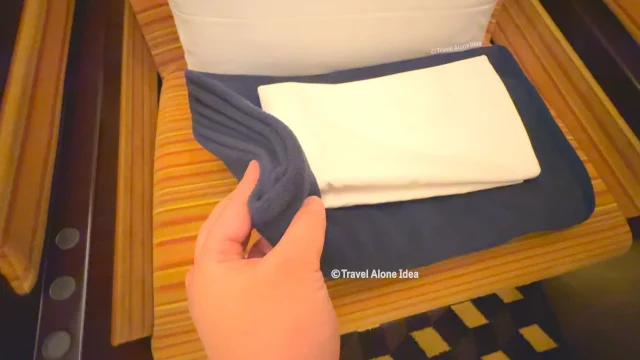
There is one pillow, one bed sheet, and one blanket on each seat. The inside of the train is air-conditioned so it is comfortable, not too hot or too cold.
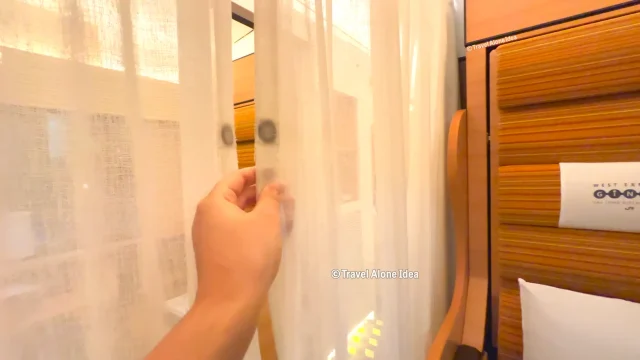
The First Seat does not have a lockable door, but when the curtain is closed, it becomes a semi-private room.
The curtains are a little bit transparent, which is a bit of a problem.
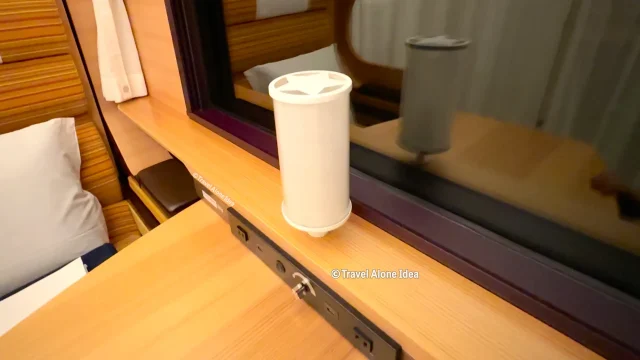
Each seat has its own table and a cute star-shaped lamp. There is plenty of legroom, so it’s so spacious.
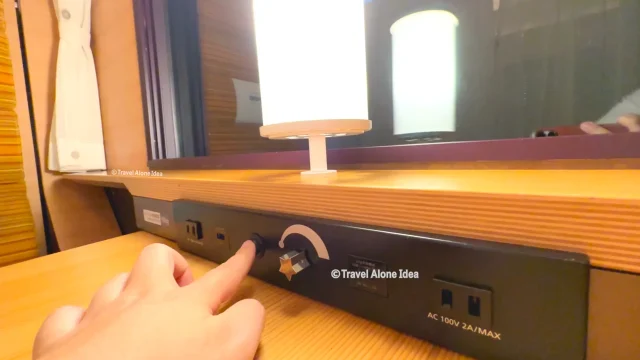
It’s nice to have two electrical outlets and two USB ports. Free Wi-Fi is also available, although it is by no means fast.
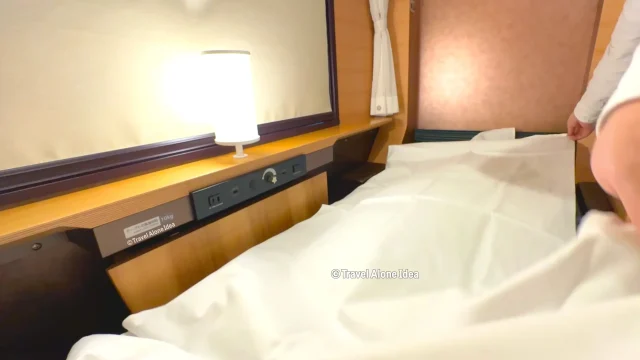
You can also use your seat as a bed by folding down the backrest of the seat. The bed sheet is well ironed and clean.
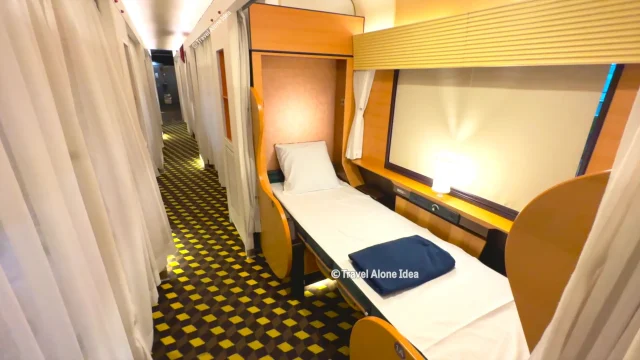
It has been transformed into exactly what we had imagined a sleeper train would look like. This is what a sleeper train is all about!
I’ve always dreamed of this!
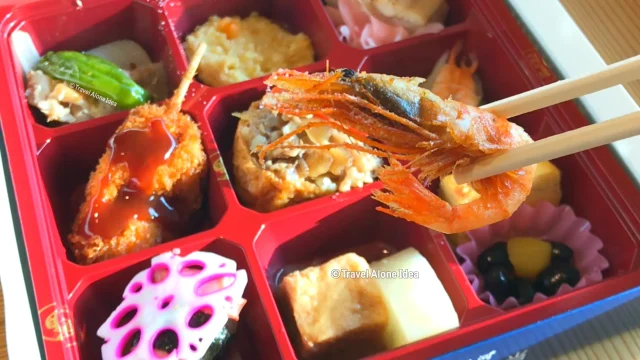
The West Express Ginga’s original lunch box looks light, but it’s actually quite hearty so it will fill you up. At stations along the way, you can enjoy short sightseeing tours and local hospitality provided by station staff.
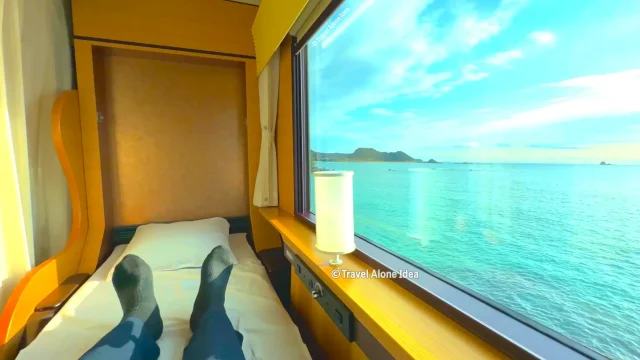
West Express Ginga’s Kinan Course runs along the coast of Wakayama Prefecture, so the early morning ocean view from the large train windows is stunning.
8. Pros and Cons of the West Express Ginga
Advantages of the West Express Ginga
The positive aspects I experienced while riding on the West Express Ginga are as follows:
- Seats can be folded down to be fully flat.
- Each seat has its own table and lamp.
- Lounges and free Wi-Fi are also available.
Disadvantages of the West Express Ginga
On the other hand, there were 3 points that I felt were not good.
- It takes a long time to reach the destination.
- The price is very expensive.
- The running sound of the train is noisy.
If I were to rate it on a scale of one to five, I’d give it 4.25.
Online Reviews of the West Express Ginga
The reviews from users who have ridden the West Express Ginga have been relatively positive. Here were some of the reviews we found online.

The price was a little high, but I’m so glad I got to ride it. It was a dream come true.

I was impressed how well they renovated the old express train.

It is a precious train that allows you to easily experience the excitement of night train travel.

We chose a private room. The seats could be folded down and transformed into a bed, but it was too small for two people to sleep.
It’s clear that many people are highly satisfied with it.
9. Latest Information about the West Express Ginga
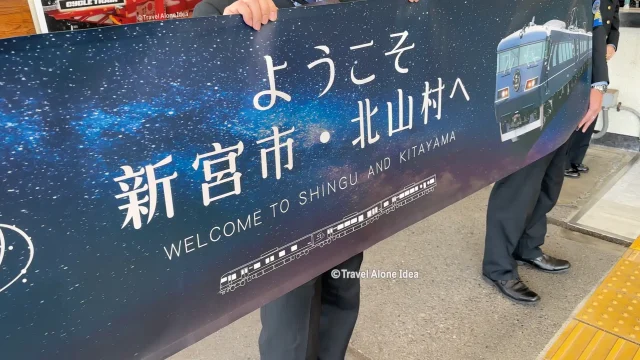
It has recently become possible to purchase a one-way ticket on the West Express Ginga. This makes it easier and less expensive to enjoy a sightseeing train trip! If price is important to you, now is the time to take advantage of it.
Previously, one-way tickets could only be purchased at the expensive package tour prices that included round-trip transportation and one night’s hotel accommodations.
10. Summary of My Experience on the West Express Ginga
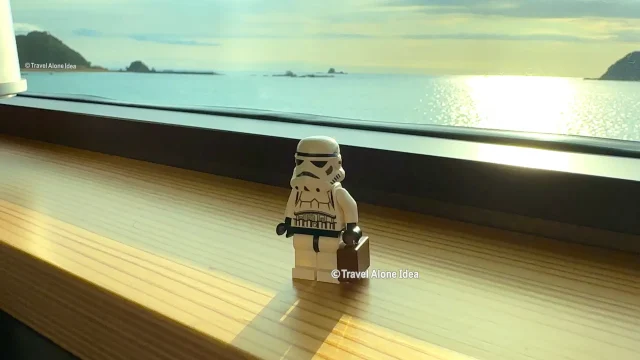
I was very satisfied with the nice design of the train and the beautiful scenery from the train window. Would you like to try it someday?
Fore more information about this trip, please check out the Travel Alone Idea’s YouTube video. [ Original Video (English Subtitles) ]
11. Frequently Asked Questions about the West Express Ginga
Finally, just for your reference, here are answers to 5 frequently asked questions about the West Express Ginga.
- A1 The West Express Ginga is a sightseeing train operated by JR West. It operates about two round trips per week, with different operating routes for each season. The concept of the train is a train where you can enjoy a casual train trip. The exterior of the train is painted in a deep blue color called “Rurikon-iro,” which represents the beautiful sea and sky that are the pride of Western Japan. The car body is a renovated 117 Series train manufactured in the Japan National Railways era for use as a sightseeing train.
The name “West Express Ginga” is derived from the meaning of the train connecting the stars, comparing the western Japan area to space and the scattered attractive regions to stars. During spring and summer, the San-in Course runs between Kyoto Station and Izumo City Station, and during fall and winter, the Kinan Course runs between Kyoto Station and Shingu Station. One of the attractions of this course is that passengers can enjoy short sightseeing and hospitality at stations along the way. Various seating and lounge spaces are available on board, including family cabins, premier rooms, and women-only cars. - A2 The fare structure of the West Express Ginga is based on the JR Set Plan trip fare, which is the base fare adjusted for differences by origin and destination, seats used, and accommodations. In the case of the Kinan Course (Kyoto Station to Shingu Station), if you use the West Express Ginga (the First Seat) for both roundtrips and the itinerary is for 3 days (1 night on the train + 1 night in a hotel), the total cost will be 36,500 yen, including hotel charges. However, the price varies depending on the class of seat and hotel used.
For example, in the case of the San-in Course (Kyoto Station to Izumo City Station), using round-trip galactic train for 3 days (2 nights in the car), the basic course fare for one adult is 40,100 yen. The additional charge per one-way trip is no extra charge for a reserved seat in a standard car (the Reclining Seat), the Nobi-Nobi seat (the Couchette), or a compartment (the Family Cabin), plus 4,510 yen for a reserved seat in a semi-private compartment (the First Seat), plus 7,500 yen for a private room (Premier Room for one or two people) will be an additional 7,500 yen. - A3 The West Express Ginga operates as a round-trip overnight train between Kyoto Station and Izumo City Station as the San-in Course from April to August. The Kinan Course runs between Kyoto Station and Shingu Station from September to March of the following year.
The San-in Course runs during the summer season, allowing passengers to enjoy the bright view from the train window for a longer period of time due to the earlier sunrise time. On the other hand, the winter Kinan Course runs along the coast of Wakayama Prefecture, allowing passengers to enjoy ocean views as the train runs along the coast. - A4 The reservations for the West Express Ginga trains were made by lottery when the trains started operation in 2020, and the odds of winning that prize were 1 in 50. However, since 2021, the reservation system for West Express Ginga has been changed to a “first-come, first-served” basis.
Currently, reservation start dates and times are listed by boarding date on the official website of Nippon Travel Agency. - A5 The stop stations and timetables for the West Express Ginga are as follows: In the case of the San-in Course outbound trains (departing from Kyoto Station, going to Izumo City Station), Kyoto Station (departing at 9:15pm), Shin-Osaka (arriving at 10:07pm / departing at 10 :17pm), Osaka (arriving at 10:21pm / departing at 10:28pm), Sannomiya (arriving at 10:50pm / departing at 10:51pm), Kobe (arriving at 10:53pm / departing at 10:55pm), Nishiakashi (arriving at 11:12pm / departing at 11:15pm), Himeji (arriving at 11:48pm / departing at 0:42am the next day), Ikuyama (arriving at 6:02am / departing at 6:34am), Yonago (arriving at 7:48am / departing at 8:18am), Yasugi (arriving at 8 :26am / departing at 8:28am), Matsue (arriving at 8:45am / departing at 8:57am), Tamatsukuri Onsen (arriving at 9:04am / departing at 9:05am), Shinji (arriving at 9:16am / departing at 9:17am), Izumo City (arriving at 9:31am). In the case of the San-in Course inbound trains (departing from Izumo City Station, going to Kyoto Station), Izumo City (departing at 4:09pm), Shinji (arriving at 4:22pm / departing at 4:23pm), Tamatsukuri Onsen (arriving at 4:32pm / departing at 4:33pm), Matsue (arriving at 4:45pm / departing at 4:51pm), Yasugi (arriving at 5:08pm / departing at 5:34pm), Yonago (arriving at 5:43pm / departing at 5:47pm), Nezu (arriving at 6:25pm / departing at 6:57pm), Bicchu Takahashi (arriving at 9:25pm / departing at 10:00pm), Kobe (arriving at 5:44am the next day / departing 5:45am), Sannomiya (arriving at 5:48am / departing at 5:49am), Osaka (arriving at 6:10am / departing at 6:12am), Shin-Osaka (arriving at 6:16am / departing at 6:17am), and Kyoto (arriving at 6:43am).
In the case of the Kinan Course outbound trains (departing from Kyoto Station, going to Izumo City Station), Kyoto (departing at 9:15pm), Shin-Osaka (arriving at 10:10pm / departing at 10:13pm), Osaka (arriving at 10:17pm / departing at 10:19pm), Wakayama (arriving at / 11:42pm / departing at 0:40am the next day), Kushimoto (arriving at 6:50am / departing at 8:00am), Kii-Katsuura (arriving at 9:05am / departing at 9:10am), and Shingu (arriving at 9:37am). In the case of the Kinan Course inbound trains (from Shingu Station to Kyoto Station): Shingu (departing at 1:02pm), Kii-Katsuura (arriving at 1:25pm / departing at 1:30pm), Taiji (arriving at 1:42pm / departing at 1:45pm), Koza (arriving at 2:20pm / departing at 2:23pm), Kushimoto (arriving at 2:31pm / departing at 3:07pm), Shusanmi (arriving at 3:46pm / departing at 4:04pm), Shirahama (arriving at 4:26pm / departing at 4:27pm), Kii Tanabe (arriving at 4:48pm / departing at 4:49pm), Gobo (arriving at 5:23pm / departing at 5:24pm), Kainan (arriving at 6:02pm / departing at 6:22pm), Wakayama (arriving at 6:33pm / departing at 6:44pm), Hineno (arriving at 7:28pm / departing at 7:31pm), Tennoji (arriving at 8:03pm / departing at 8:05pm), Osaka (arriving at 8:16pm / departing at 8:17pm), Shin-Osaka (arriving at 8:21pm / departing at 8:22pm), and Kyoto (arriving at 8:53pm). The stops and timetables have changed slightly since I used the service, but the stops and timetables listed in this article are the latest after the changes.
I hope this helps with your future travel ideas.

